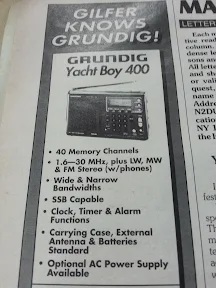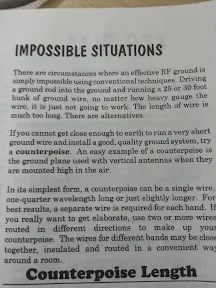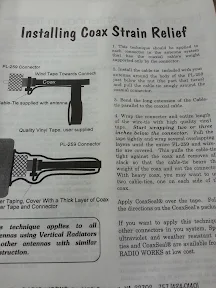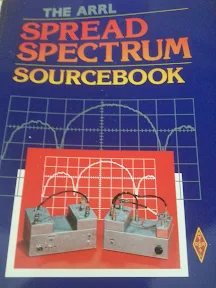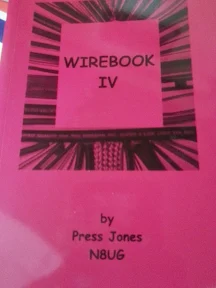Total Pageviews
Popular Posts
-
Having Space Constraint At Your QTH To Put Up An Antenna For HF Band?. Then Try Constructing This Magnetic Loop Antenna. D...
-
There is calculator for building magnetic loop antenna. Try this calculator, to see hows the performance before making you own magnetic loop...
-
Maybe some of us are regretting about their ISP ( Ex: Celcom broadband in Malaysia ) blocking ports for Echolink. This method also applicabl...
-
DroidPSK is an app for Android to decode and encode Ham Radio BPSK31 with the build in microphone/speaker or wired to your radio. A waterf...
Friday, October 11, 2013
Thursday, October 10, 2013
Wednesday, October 09, 2013
Friday, October 04, 2013
CW Iambic, Straight, Cootie And Bug Keyer
 |
| Iambic or paddle key |
 |
| Straight key |
 |
| Cootie or sidesweeper key |
 |
| Bug or semi auto key |
Many ham radio operators choose paddle instead of straight key, cootie or bug keyer. Most of modern transceiver supports iambic keying without any external circuits.
Iambic method of send is very useful for high speed operators. Default setting and default wiring will produce dits on thumb and dah on index finger for righthanded operators.
Straight key is one of the oldest method for sending cw messages. It works like simple circuit switch. Press to on, release to off. It don't need any extra circuits like iambic.
Cootie key looks like other iambic key but it doesn't produce iambic keying. Although it has 2 terminals, it wont produce any dits or dahs. You need to make it by sliding the single paddle to the left or right. Longer touch to the terminals will produce dahs sound. Vise versa. It don't nees any extra circuits.
Bug keyer is the first mechanical that can send continuous dits sound, also named as semi automatic keyer. Only continuous dits sound, not for dahs. You need to make dahs sound manually. It don't need any extra circuits.
Thursday, October 03, 2013
CW Abbreviations And Prosigns
To those who wants to make your first cw qso on the air, it is a good effort to learn about cw abbreviations and prosigns.
Most ham radio operator will use standard cw abbreviations in their cw qso. Some will use their own abbreviations based on their languages.
Standard cw abbreviations are:-
1. GM - good morning
2. GE - good evening
3. GA - good afternoon
4. GN - good night
5. DR - dear
6. OM - old man
7. GL - good luck
8. GDX - good dx
9. SRI - sorry
10. FB - fine business
11. PSE - please
12. ABT - about
13. R - roger
14. TKS - thanks
15. TU - thank you
16. FER - for
17. CFM - confirm
18. ANT - antenna
19. UR - you are
20. TX - transmit
21. RX - receive
22. 5NN - 599
23. HR - here
24. NR - number
25. ES - and
26. HIHI - laughing
27. XYL - wife
28. YL - a young lady/girl
29. TNX - thanks
30. WX - weather
31. TEMP - temperature
32. SIG - signal
33. HW - how
34. CPY/CPI - copy
35. HPE - hope
36. CUL - see you later
37. AGN - again
38. CUAGN - see you again
These are some prosigns that were used in cw qso.
1. AR - end of message
2. K - over/go ahead
3. DE - from/this is
4. BT - pause between transmission
5. BK - break
6. KN - over to specific station only and not allowing other station to interrupt
7. AS - please standby
8. CL - clear
9. SK - end of contact
just remember that prosigns must be send as signal letter sound. No spacing at all. for example, BT must be send as dadididida. Not dadididit dah.
But it is different for cw abbreviations since cw abbreviations observe interletter spacing just like normal words.
If you want to know more about cw abbreviations, please visit http://en.wikipedia.org/wiki/Morse_code_abbreviations
Most ham radio operator will use standard cw abbreviations in their cw qso. Some will use their own abbreviations based on their languages.
Standard cw abbreviations are:-
1. GM - good morning
2. GE - good evening
3. GA - good afternoon
4. GN - good night
5. DR - dear
6. OM - old man
7. GL - good luck
8. GDX - good dx
9. SRI - sorry
10. FB - fine business
11. PSE - please
12. ABT - about
13. R - roger
14. TKS - thanks
15. TU - thank you
16. FER - for
17. CFM - confirm
18. ANT - antenna
19. UR - you are
20. TX - transmit
21. RX - receive
22. 5NN - 599
23. HR - here
24. NR - number
25. ES - and
26. HIHI - laughing
27. XYL - wife
28. YL - a young lady/girl
29. TNX - thanks
30. WX - weather
31. TEMP - temperature
32. SIG - signal
33. HW - how
34. CPY/CPI - copy
35. HPE - hope
36. CUL - see you later
37. AGN - again
38. CUAGN - see you again
These are some prosigns that were used in cw qso.
1. AR - end of message
2. K - over/go ahead
3. DE - from/this is
4. BT - pause between transmission
5. BK - break
6. KN - over to specific station only and not allowing other station to interrupt
7. AS - please standby
8. CL - clear
9. SK - end of contact
just remember that prosigns must be send as signal letter sound. No spacing at all. for example, BT must be send as dadididida. Not dadididit dah.
But it is different for cw abbreviations since cw abbreviations observe interletter spacing just like normal words.
If you want to know more about cw abbreviations, please visit http://en.wikipedia.org/wiki/Morse_code_abbreviations
CW Sidetone Volume Adjustment
To adjust CW sidetone for yaesu transceivers is easy since it has adjustable value on its function mode.
You can adjust to your preferrable volume by tuning the dial knob to the left or right.
Elecraft has hidden function for this setting, you need to press the 3 function knob. just read the manual if you don't know.
I have tried icom ic706mk2g, the way to adjust cw sidetone for this transceiver is different. You need to turn the side yellow coloured screw on right side of that radio.
Speech processor gain also located beside the cw tone volume screw. some high end transceivers has their dedicated knob for cw sidetone adjustment.
You can adjust to your preferrable volume by tuning the dial knob to the left or right.
Elecraft has hidden function for this setting, you need to press the 3 function knob. just read the manual if you don't know.
I have tried icom ic706mk2g, the way to adjust cw sidetone for this transceiver is different. You need to turn the side yellow coloured screw on right side of that radio.
Speech processor gain also located beside the cw tone volume screw. some high end transceivers has their dedicated knob for cw sidetone adjustment.
Yaesu FT857 FT897 CW Message Memory
Yaesi FT857 and FT897 has their own memory for cw messages storage.
Button A B and C can be programmed to storage short lengthened messages for example, CQ CQ DE 9Μ2PJU, TNX FER QSO 73 or UR 5NN K.
For A button, we can use it as looping message useful for beaconing operation.
It can be set to automatically transmit for example once in a minute.
You can set it to send CQ call once in a minute. If you hear any station replying your call, you can either reply to his call manually using your keyer or by pressing B button which already programmed with reply message.
isn't is useful enough for you?
But if you want to send longer messages, better use 3rd party devices or your personal computer installed with cw interface.
Button A B and C can be programmed to storage short lengthened messages for example, CQ CQ DE 9Μ2PJU, TNX FER QSO 73 or UR 5NN K.
For A button, we can use it as looping message useful for beaconing operation.
It can be set to automatically transmit for example once in a minute.
You can set it to send CQ call once in a minute. If you hear any station replying your call, you can either reply to his call manually using your keyer or by pressing B button which already programmed with reply message.
isn't is useful enough for you?
But if you want to send longer messages, better use 3rd party devices or your personal computer installed with cw interface.
CW Break In Function
I have tried icom, yaesu, sgc, kenwood, elecraft transceivers and their setting for cw break in is totally different.
For yaesu, icom and sgc, you need to be on cw mode and push on the break in button which usually named as BK.
for elecraft and icom, you need to switch to cw mode and push on the VOX function to make those transceiver to transmit on cw mode.
Without switching on the break in function, your transceivers will only making cw tone without transmitting.
It is important to read transceivers manual before operating. A good ham radio operator will always keep his transceivers manual beside his transceivers in their shack.
For yaesu, icom and sgc, you need to be on cw mode and push on the break in button which usually named as BK.
for elecraft and icom, you need to switch to cw mode and push on the VOX function to make those transceiver to transmit on cw mode.
Without switching on the break in function, your transceivers will only making cw tone without transmitting.
It is important to read transceivers manual before operating. A good ham radio operator will always keep his transceivers manual beside his transceivers in their shack.
Rigtalk USB Dongle
Rigtalk from westmountainradio.com is a USB to TTL level interface for CI-V and CAT Radios. Supports most of radio from Icom, Tentec and also Yaesu with seperated cables.
It is Pocket Sized USB Dongle Design, supporting and Tested With Most Rig Control & Logging Software.
Compatible with computer that has USB 2.0 or Lower.
Great for dxers and contesters.

It is Pocket Sized USB Dongle Design, supporting and Tested With Most Rig Control & Logging Software.
Compatible with computer that has USB 2.0 or Lower.
Great for dxers and contesters.

Wednesday, October 02, 2013
CW Phenomenon In Malaysia
CW operation not so popular here in Malaysia. although we still have cw examination here, the population of cw operator is still little compared to other countries. The most factor was ham radio population in Malaysia is not big as our neighbor, Indonesia.
But Malaysian ham radio operator is still the winner if we compare to Singaporean hams. But we lose if compared to Indonesian hams.
if you listen to 40 meters, you will hear Indonesian hams on almost range of freqs.
The popular freq for Malaysian hams was on 7130khz and 7043khz. Before 7043, I was told that 7040khz was favourite spot for Malaysian ham in year 90s.
Back to the topic, Some more reasons that Malaysian is still lack of CW operators were
1. Afraid to make first on air cw contact
2. Do not know cw prowords and abbreviations
3. don't have supportive friends
4. Do not have cw keyer
5. don't want to operate cw at all
In Malaysian cw test, there is only alphabet and numbers and only one or two character such as period and commas.
To be a cw operator, we need to learn cw prowords, punctual letters and also cw abbreviations.
for sure it takes time to learn all this, especially if we don't have any reading resources.
Friends can help friends, just find suitable and experienced friends and learn from them.
we need to learn walking before running.
But Malaysian ham radio operator is still the winner if we compare to Singaporean hams. But we lose if compared to Indonesian hams.
if you listen to 40 meters, you will hear Indonesian hams on almost range of freqs.
The popular freq for Malaysian hams was on 7130khz and 7043khz. Before 7043, I was told that 7040khz was favourite spot for Malaysian ham in year 90s.
Back to the topic, Some more reasons that Malaysian is still lack of CW operators were
1. Afraid to make first on air cw contact
2. Do not know cw prowords and abbreviations
3. don't have supportive friends
4. Do not have cw keyer
5. don't want to operate cw at all
In Malaysian cw test, there is only alphabet and numbers and only one or two character such as period and commas.
To be a cw operator, we need to learn cw prowords, punctual letters and also cw abbreviations.
for sure it takes time to learn all this, especially if we don't have any reading resources.
Friends can help friends, just find suitable and experienced friends and learn from them.
we need to learn walking before running.
Stupid friends and clever foes
you are living in a wonderful world if you have bunch of clever friends. Of course you will insist to have stupid friends along with you.
But if you were unlucky, you will have a bunch of stupid friends with bunch of clever foes.
if you do, Which side you will choose to listen? stupid friends or clever foes?
But if you were unlucky, you will have a bunch of stupid friends with bunch of clever foes.
if you do, Which side you will choose to listen? stupid friends or clever foes?
Base Station Operation
When operating from a base station, we usually don't use 9m2pju base as our callsign. Just simply tell them this is 9m2pju. We don't need any extra arguments after pronouncing our callsign
But if you listen to any 2m repeaters, there were some people telling that they are in their bases. Why bother? Just tell your callsign and it is enough to tell anyone that you are operating from your bases. I don't hear any dx stations saying that they were on their base on 20m or 40m yet.
Unless when they are operating from their mobile station or from temporary station.
How about cw operation? Do you send your callsign and base after your callsign? Like this, 9m2pju/base? Or 9m2pju/b?
don't be a laughing stock, b means beacon, not base. Just pronounce your callsign and that is enough to tell others that you are operating from your base station. Indeed.
But if you listen to any 2m repeaters, there were some people telling that they are in their bases. Why bother? Just tell your callsign and it is enough to tell anyone that you are operating from your bases. I don't hear any dx stations saying that they were on their base on 20m or 40m yet.
Unless when they are operating from their mobile station or from temporary station.
How about cw operation? Do you send your callsign and base after your callsign? Like this, 9m2pju/base? Or 9m2pju/b?
don't be a laughing stock, b means beacon, not base. Just pronounce your callsign and that is enough to tell others that you are operating from your base station. Indeed.
Portable Or Mobile Station
We usually heard some station saying 9w2xxx portable or 9w2xxx mobile.
first he said that he is mobile and then when he stopped his car, he said that he is portable.
Did you know that mobile station is still mobile station. No matter on the move or not.
the correct term for a car that is not moving is stationary mobile. Not portable.
since portable usually used for a temporary station for example a station under a tent or a chalet that was not owned by the station himselves.
Second situation is when using a handytalkie. If we are walking from a to b while talking to a handytalkie, the correct term is walking mobile or pedestrian mobile. No matter what type transceivers we are using. usually battery powered devices. But if we use handytalkie inside our shack, It is still a base station. Do not use 9w2xxx portable on base. that is absolutely wrong.
Mobile doesnt mean moving by a car. Mobile definition is movable. Same like mobile phones. Phone that movable. Not physically wired to any link.
We need to learn basic of procedure words such as
1. Mobile
2. Stationary mobile
3. Portable
4. Walking mobile
5. Pedestrian mobile
6. Aeronautical mobile
7. Maritime mobile
9. Parachute mobile
first he said that he is mobile and then when he stopped his car, he said that he is portable.
Did you know that mobile station is still mobile station. No matter on the move or not.
the correct term for a car that is not moving is stationary mobile. Not portable.
since portable usually used for a temporary station for example a station under a tent or a chalet that was not owned by the station himselves.
Second situation is when using a handytalkie. If we are walking from a to b while talking to a handytalkie, the correct term is walking mobile or pedestrian mobile. No matter what type transceivers we are using. usually battery powered devices. But if we use handytalkie inside our shack, It is still a base station. Do not use 9w2xxx portable on base. that is absolutely wrong.
Mobile doesnt mean moving by a car. Mobile definition is movable. Same like mobile phones. Phone that movable. Not physically wired to any link.
We need to learn basic of procedure words such as
1. Mobile
2. Stationary mobile
3. Portable
4. Walking mobile
5. Pedestrian mobile
6. Aeronautical mobile
7. Maritime mobile
9. Parachute mobile
Beginners 2 Meter Band Antenna
Congratulations if you passed you first amateur radio examination. If you just pickup your first ticket, and already have a handytalkie or any vhf transceiver, maybe you need to do something as your first ham radio project.
I suggesting 2 meter antenna brewing. There are lots of 2m antenna designs, but if if you already had one in your mind, just proceed with your selected design.
If you still wondering which one to build, I may suggest a few for you
1. Dipole
2. Quarter wave with ground plane
3. Slimjim
4. Zepp
5. quad
6. Halo
I suggesting 2 meter antenna brewing. There are lots of 2m antenna designs, but if if you already had one in your mind, just proceed with your selected design.
If you still wondering which one to build, I may suggest a few for you
1. Dipole
2. Quarter wave with ground plane
3. Slimjim
4. Zepp
5. quad
6. Halo
Mobile Station Rig
Since 2009, I own an ICOM IC-2200H on my mobile station. I have 2 antennas for it, a loaded quarter wave whip and a 5/8 whip.
I usually use it for simplex and repeater analog voice operation.
When I'm in urban area such a kuala lumpur, I always use my loaded quarter wave since it wont giving me any problem to enter any basement parking lots.
But when I'm in rural area I will use my 5/8 whip since it has better reception and transmitting performance.
I've made an air choke balun on the transmission cable, nearer to my rig and attached a ferrite core to it.
I use external speaker made by MFJ for better sound and tone quality.
I like my rig since i can listen to AM mode. Listening air traffic control tower talking to a pilot is fun when you are stucked in traffic jam.
How about your mobile station?
I usually use it for simplex and repeater analog voice operation.
When I'm in urban area such a kuala lumpur, I always use my loaded quarter wave since it wont giving me any problem to enter any basement parking lots.
But when I'm in rural area I will use my 5/8 whip since it has better reception and transmitting performance.
I've made an air choke balun on the transmission cable, nearer to my rig and attached a ferrite core to it.
I use external speaker made by MFJ for better sound and tone quality.
I like my rig since i can listen to AM mode. Listening air traffic control tower talking to a pilot is fun when you are stucked in traffic jam.
How about your mobile station?
W5GI Antenna
I've been using G5RV antenna for at least. 3 years now. G5RV performs very well on 20 meters band. I've made contacts with 117 DXCC using only G5RV. Mine is junior sized.
I am thinking to try new antenna. My choice is still from wire antenna. Comparing G5RV with W5GI, I think W5GI is better since it has 6 radiation lobes on 20 meters band while G5RV only have 4 lobes.
I read about this antenna from ham radio magazine long time ago but had no chance to think about it.
Maybe it is time for a change.
I am thinking to try new antenna. My choice is still from wire antenna. Comparing G5RV with W5GI, I think W5GI is better since it has 6 radiation lobes on 20 meters band while G5RV only have 4 lobes.
I read about this antenna from ham radio magazine long time ago but had no chance to think about it.
Maybe it is time for a change.
How To Break Into Pile Up Call
When there is some rare dxpedition, many ham radio will try to work with that station.
if you hear on their operating frequencies, you will hear bunch of pile up call from around the world.
How to break into their pile up calls?
for CW or SSB operation, you can try to transmit a little bit higher or lower than their receiving frequency.
If you transmit higher, they will easily listen to you call because of your signal sounded a little bit narrow or higher pitch than others.
Depends on their receiver filterations too if they use narrow filter, your signal probably cannot be heard at all. The best technique is to have a bigger gun and higher gain antenna than others.
if you hear on their operating frequencies, you will hear bunch of pile up call from around the world.
How to break into their pile up calls?
for CW or SSB operation, you can try to transmit a little bit higher or lower than their receiving frequency.
If you transmit higher, they will easily listen to you call because of your signal sounded a little bit narrow or higher pitch than others.
Depends on their receiver filterations too if they use narrow filter, your signal probably cannot be heard at all. The best technique is to have a bigger gun and higher gain antenna than others.
How To Handle Pile Up Call
When making CQ call on DX band, usually DX stations will answering our call continuously without any delay. We will hear bunch of audios from many countries.
This situation known as pile up call.
How to handle them?
First we need to know what is terminology of KISS method. Some will spell as keep it short and simple and some will say keep it short stupid!
Read sample of dialog below
A: cq cq this is a
B: a this is b
C: a this is c
D: a this is d
A: b stn, is it correct you are b?
B: yes this is b
A: ok b stn you are 59 over
B: thanks you also 59. Bye.
nothing's problem with dialog above, but if you are on that situation, you can make it faster than dialog above. For example
A: cq cq de a stn
B: a this is b stn
A: b stn you are 59 over
B: a this is b stn, you are 59 too.
See the differences?
if you are observant enough, of course you can tell other stations report by hearing their first call to you.
This situation known as pile up call.
How to handle them?
First we need to know what is terminology of KISS method. Some will spell as keep it short and simple and some will say keep it short stupid!
Read sample of dialog below
A: cq cq this is a
B: a this is b
C: a this is c
D: a this is d
A: b stn, is it correct you are b?
B: yes this is b
A: ok b stn you are 59 over
B: thanks you also 59. Bye.
nothing's problem with dialog above, but if you are on that situation, you can make it faster than dialog above. For example
A: cq cq de a stn
B: a this is b stn
A: b stn you are 59 over
B: a this is b stn, you are 59 too.
See the differences?
if you are observant enough, of course you can tell other stations report by hearing their first call to you.
Subscribe to:
Posts (Atom)











